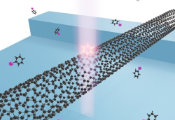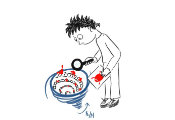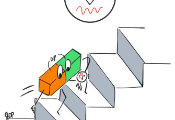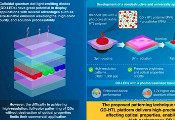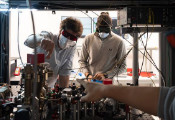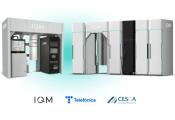Start-Up Brings Quantum Sensor to Market Maturity
December 04, 2024 -- Whether beer, coffee beans, yogurt or lubricating oil: A device small enough to fit into one hand can measure the shelf life of substances. The idea: To bring this technology to the food industry. As a start-up, this spin-off from the University of Stuttgart will receive funding from the EXIST research transfer program of the Federal Ministry of Economics and Climate Protection (BMWK).
“This quantum sensor technology is already just around the corner. Now we need to launch it on the market with full momentum," says Prof. Jens Anders. This is exactly what four young men are working on. With their spin-off, SpinMagIC, they aim to make it easy to measure the self-life of products using a quantum sensor. Two of them, Belal Alnajjar and Anh Chu, are Anders’ doctoral researchers and work in the labs at the University of Stuttgart's Institute for Smart Sensors (IIS). The other two - physics doctoral researcher Michele Segantini and Jakob Fitschen, who is responsible for financially managing the spin-off and making it profitable - work from Helmholtz Zentrum Berlin (HZB), supported by Prof. Klaus Lips, head of the “Spins in Energy Conversion and Quantum Information Science” department. Anders and Lips are very familiar with measuring electron spin resonances, or ESR for short. A method that measures particularly reactive molecules. They received the notable HZB-Award for Technology Transfer in 2019.
Teamwork in Stuttgart and Berlin to develop wearable quantum sensor
The go-ahead for funding from the BMWK was given on October 1, 2024, and the four founders now have two years to make their spin-off a success. The doctoral students are supported by the Institute for Entrepreneurship (ENI), the technology transfer initiative TTI GmbH [DE] and the transfer center TRACES at the University of Stuttgart, together with the state initiative “NXTGN” [DE] (known before as "Gründermotor"). The three doctoral students from Stuttgart and Berlin have been working together on different projects for several years and know each other very well. Jakob Fitschen joined six months ago. Teamwork is paramount in the development of the highly complex wearable quantum sensor.
SpinMagIC relies on quantum sensors that detect reactive molecules, so-called free radicals. Any material that has unpaired electrons can be quantitatively measured with the sensor. Free radicals, for example, cause skin to age more quickly. They are also responsible for the decomposition of food. ESR have been used to measure free radicals “for 80 years”, notes Anders. Until now, their use was limited because the devices were too bulky, weighed at least a ton and cost several hundred thousand euros. Even available table-top devices weigh around 120 kilograms and are very expensive. This is an issue that calls into question efficient processes or broad application. This is now changing abruptly, and miniaturization is the magic word. All the researchers need to measure the shelf-life of products is a small permanent magnet and a microchip with an integrated circuit.
Measuring the shelf life of liquids using free radicals
How does the measurement work? The microchip is no more than one square millimeter in size. It consists of all high-frequency circuit components that excite the unpaired electrons and sense their quantum responses. For the measurement process, the researchers switch on a micropump that transports the sample onto the chip or immerse the sensor directly in the liquid to be measured. The number of free radicals is shown on the display. “Using 3D-printed structures made of lightweight filament provides a cost-effective way to realize powerful resonance magnets,” emphasizes physicist Alnajjar. Before the printing process, he conducted numerous simulations to determine the optimal solution. The magnet from the 3D printer now weighs around 40 grams. The inside of the magnet consists of rings. "The rings are selected to ensure that the magnetic field is highly homogeneous," says Alnajjar. The low weight and high quality are key characteristics of these magnets.
The researchers are proud of the neologism SpinMagIC - three components of the measurement: Spin stands for the electrons, which have their own angular momentum, Mag for magnet, which enables the measurement, and IC for the integrated circuit. The division of tasks is clear: “We in Stuttgart are responsible for developing the core technology,” emphasizes electrical engineer Chu. These are the permanent magnet and the circuit board that carries a tiny chip-integrated quantum sensor. Segantini, the physicist in Berlin, looks at applications based on initial findings, such as measuring food shelf life. In particular, he has good connections to the olive oil production sector. The plan is to have the end product ready for the market in two years and to acquire the first pilot customers to test it. "Extremely small, incredibly affordable, and with very high measurement accuracy," says Chu, highlighting the stringent requirements of the food industry and the strong incentive it provides.
Uses range from food and pharmaceutical industries to measuring environmental pollution
The method could be used to determine the condition of rechargeable batteries, or even for catalytic processes commonly used in the chemical industry, such as those involved in the polymerization of molecules. Its use within the pharmaceutical industry is also conceivable, as is measuring contamination in the air or water. “We have a fixed budget from the BMWK for the next two years,” says Chu. The financing for the spin-off is therefore secured. "But we are also open to venture capitalists and private investors."
The parts do not yet fit into a smartwatch. However, the researchers plan to eventually integrate the measurement equipment into an even smaller device in the long term.

